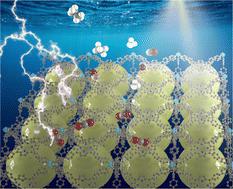当前位置:
X-MOL 学术
›
Energy Environ. Sci.
›
论文详情
Our official English website, www.x-mol.net, welcomes your feedback! (Note: you will need to create a separate account there.)
Porphyrin-based metal–organic frameworks for photo(electro)catalytic CO2 reduction
Energy & Environmental Science ( IF 32.4 ) Pub Date : 2024-06-17 , DOI: 10.1039/d4ee01748j Guixiang Ding , Chunxue Li , Lihui Chen , Guangfu Liao
Energy & Environmental Science ( IF 32.4 ) Pub Date : 2024-06-17 , DOI: 10.1039/d4ee01748j Guixiang Ding , Chunxue Li , Lihui Chen , Guangfu Liao

|
Amidst the significant challenges posed by global climate change and the need for sustainable resource recycling, there is a pressing demand for the development of new materials that offer high cost-effectiveness, exceptional conversion efficiency, and robust stability to facilitate the conversion of CO2 into high-value products. Metal–organic frameworks (MOFs), which incorporate versatile porphyrin fragments, have emerged as promising candidates in the realm of photo(electro)catalytic CO2 reduction. Given their straightforward synthesis, tunable structure, chemical stability, and abundance of active sites, MOFs enriched with specific functional porphyrins can be precisely incorporated through in situ self-assembly or post-synthesis techniques, thereby broadening the scope of design possibilities for porphyrin-based MOFs. This comprehensive review delves into the rational design principles and recent advancements in the utilization of porphyrin-based MOFs for photo(electro)catalytic CO2 reduction. It elucidates the synthesis methods and CO2 interaction mechanisms, and delves into the latest research endeavors encompassing catalyst structure optimization, activity enhancement, selectivity control, and other pivotal breakthroughs. Furthermore, it conducts a detailed analysis of the current technical challenges, future trends, and the promising prospects of porphyrin-based MOFs in driving the industrialization of this technology. By offering a thorough theoretical framework and practical insights, this review serves as a valuable resource for enhancing the understanding and application of porphyrin-based MOFs in high-value conversion of CO2, thereby paving the way for improved catalytic performance and the successful implementation of this technology.
中文翻译:

用于光(电)催化二氧化碳还原的卟啉基金属有机框架
面对全球气候变化带来的重大挑战和可持续资源回收的需求,迫切需要开发具有高成本效益、卓越的转化效率和强大稳定性的新材料,以促进二氧化碳的转化 2 转化为高价值产品。金属有机框架(MOF)包含多种卟啉片段,已成为光(电)催化 CO 2 还原领域有前景的候选材料。鉴于其合成简单、结构可调、化学稳定性和丰富的活性位点,富含特定功能性卟啉的 MOF 可以通过原位自组装或合成后技术精确整合,从而拓宽了基于卟啉的设计可能性范围MOF。这篇综合综述深入探讨了利用卟啉基 MOF 进行光(电)催化 CO 2 还原的合理设计原理和最新进展。它阐明了合成方法和CO 2 相互作用机制,并深入研究了催化剂结构优化、活性增强、选择性控制和其他关键突破等最新研究成果。此外,还详细分析了卟啉基MOFs当前的技术挑战、未来趋势以及推动该技术产业化的前景。 通过提供全面的理论框架和实践见解,这篇综述为增强对卟啉基 MOF 在 CO 高价值转化中的理解和应用提供了宝贵的资源 2 ,从而为改进催化铺平了道路。性能以及该技术的成功实施。
更新日期:2024-06-17
中文翻译:

用于光(电)催化二氧化碳还原的卟啉基金属有机框架
面对全球气候变化带来的重大挑战和可持续资源回收的需求,迫切需要开发具有高成本效益、卓越的转化效率和强大稳定性的新材料,以促进二氧化碳的转化 2 转化为高价值产品。金属有机框架(MOF)包含多种卟啉片段,已成为光(电)催化 CO 2 还原领域有前景的候选材料。鉴于其合成简单、结构可调、化学稳定性和丰富的活性位点,富含特定功能性卟啉的 MOF 可以通过原位自组装或合成后技术精确整合,从而拓宽了基于卟啉的设计可能性范围MOF。这篇综合综述深入探讨了利用卟啉基 MOF 进行光(电)催化 CO 2 还原的合理设计原理和最新进展。它阐明了合成方法和CO 2 相互作用机制,并深入研究了催化剂结构优化、活性增强、选择性控制和其他关键突破等最新研究成果。此外,还详细分析了卟啉基MOFs当前的技术挑战、未来趋势以及推动该技术产业化的前景。 通过提供全面的理论框架和实践见解,这篇综述为增强对卟啉基 MOF 在 CO 高价值转化中的理解和应用提供了宝贵的资源 2 ,从而为改进催化铺平了道路。性能以及该技术的成功实施。






































 京公网安备 11010802027423号
京公网安备 11010802027423号